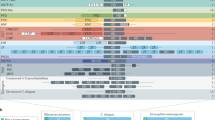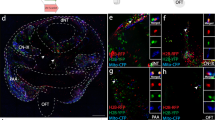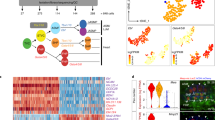Abstract
IN the chick embryo hindbrain, morphological segmentation into rhormbomeres is matched by metameric patterns of early neuronal differentiation and axonogenesis1. Boundaries between rhombomeres coincide with boundaries of expression of murine regulatory genes2–4. By clonal analysis using intracellular marking, we show here that the rhombomere boundaries are partitions across which cells do not move. When a parent cell is marked before the appearance of rhombomere boundaries, the resulting clone is able to spread into the neighbouring rhombomere. When marked after boundary appearance, the clone still expands freely within the rhombomere of origin, but it is now restricted at the boundaries. Rhombomeres in the chick embryo thus behave like polyclonal units, raising the possibility that they are analogous to the compart-ments of insects.
This is a preview of subscription content, access via your institution
Access options
Subscribe to this journal
Receive 51 print issues and online access
$199.00 per year
only $3.90 per issue
Buy this article
- Purchase on Springer Link
- Instant access to full article PDF
Prices may be subject to local taxes which are calculated during checkout
Similar content being viewed by others
References
Lumsden, A. & Keynes, R. Nature 337, 424–428 (1989).
Wilkinson, D. G., Bhatt, S., Chavrier, P., Bravo, P. & Charnay, P. Nature 337, 461–464 (1989).
Murphy, P., Davidson, D. R. & Hill, R. E. Nature 341, 156–159 (1989).
Wilkinson, D. G., Bhatt, S., Cook, M., Boncinelli, E. & Krumlauf, R. Nature 341, 405–409 (1989).
Garcia-Bellido, A. CIBA Fdn. Symp. 29, 161–182 (1975).
Morata, G. & Lawrence, P. A. Nature 255, 614–617 (1975).
Morata, G. & Lawrence, P. A. Nature 265, 211–216 (1977).
Lawrence, P. A. Cell 26, 3–10 (1981).
Gimlich, R. L. & Braun, J. Devl Biol. 109, 509–514 (1985).
Wetts, R. & Fraser, S. E. Science 239, 1142–1145 (1988).
Wetts, R., Serbedzija, G. N. & Fraser, S. E. Devl Biol. 136, 254–263 (1989).
Bronner-Fraser, M. & Fraser, S. E. Nature 335, 161–164 (1988).
Hamburger, V. & Hamilton, H. L. J. Morph. 88, 49–92 (1951).
Vaage, S. Adv. Anat. Embryol. Cell Biol. 41, 1–88 (1969).
Dodd, J., Morton, S. B., Karagogeos, D., Yamamoto, M. & Jessell, T. M. Neuron 1, 105–116 (1988).
Tessier-Lavigne, M., Placzek, M., Lumsden, A. G. S., Dodd, J. & Jessel, T. M. Nature 336, 775–778 (1988).
Maden, M., Ong, D. E., Summerbell, D. & Chytil, F. Development 107 Supplement 109–119 (1989).
Jessell, T. M., Bovolenta, P., Placzek, M., Tessier-Lavigne, M. & Dodd, J. CIBA Fdn. Symp. 144, 255–280 (1989).
O'Brochta, D. & Bryant, P. Nature 313, 138–141 (1985).
Patel, N. H. et al. Cell 58, 955–968 (1989).
Wilkinson, D. G., Bailes, J. A. & McMahon, A. P. Cell 50, 79–88 (1987).
Fujita, S. Expl Cell Res. 28, 52–60 (1962).
Author information
Authors and Affiliations
Rights and permissions
About this article
Cite this article
Fraser, S., Keynes, R. & Lumsden, A. Segmentation in the chick embryo hindbrain is defined by cell lineage restrictions. Nature 344, 431–435 (1990). https://doi.org/10.1038/344431a0
Received:
Accepted:
Issue Date:
DOI: https://doi.org/10.1038/344431a0
This article is cited by
-
Redundant type II cadherins define neuroepithelial cell states for cytoarchitectonic robustness
Communications Biology (2020)
-
BDNF and NGF signals originating from sensory ganglia promote cranial motor axon growth
Experimental Brain Research (2020)
Comments
By submitting a comment you agree to abide by our Terms and Community Guidelines. If you find something abusive or that does not comply with our terms or guidelines please flag it as inappropriate.



